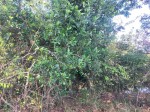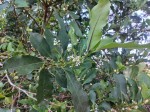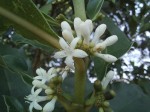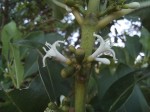| Home | > | List of families | > | Rubiaceae | > | Tricalysia | > | bagshawei |
Tricalysia bagshawei
malaissei
Selected images: Click on each image to see a larger version and details of the record View all images (4)
Habit
Riverine forest fringe
Zambezi Rapids, c. 5 km N of Kalene Hill, Ikelenge District
Oct 2024
Photo: Nick Wightman
Inflorescence
Riverine forest fringe
Zambezi Rapids, c. 5 km N of Kalene Hill, Ikelenge District
Oct 2024
Photo: Nick Wightman
Flowers
Riverine forest fringe
Zambezi Rapids, c. 5 km N of Kalene Hill, Ikelenge District
Oct 2024
Photo: Nick Wightman
Flowers
Riverine forest fringe
Zambezi Rapids, c. 5 km N of Kalene Hill, Ikelenge District
Oct 2024
Photo: Nick Wightman
Detailed records: Display species records QDS maps by: Google Maps Point records by Google Maps
Species details: Click on each item to see an explanation of that item (Note: opens a new window)
| Synonyms: | |
| Common names: | |
| Frequency: | |
| Status: | |
| Description: |
Tree or small shrub 1.5–4(6) m high; young twigs pubescent; older stems with greyish, pale brown or red-brown bark. Leaf blades 5–13 × 1.5–3.5(5) cm, elliptic, broadly elliptic or narrowly obovate, acute to subacuminate or acuminate at the apex, cuneate or rounded at the base, subcoriaceous or coriaceous, glabrous on both surfaces; midrib lightly impressed and glabrous or pubescent towards base above, prominent and pubescent beneath; lateral nerves in 3–5 main pairs, apparent on both surfaces; tertiary nerves apparent on both surfaces or obscure below; domatia hairy or sparsely hairy, sometimes with a very shallow pocket or cavity, sometimes absent; petiole 2–5 mm long, pubescent, puberulous or sparsely puberulous; stipule limb 1.25–2 mm long, pubescent or puberulous outside, with awns 1–5 mm long. Inflorescences subtended by leaves, but a few borne at naked nodes, (1)3–5-flowered; peduncles 0–1 mm long; 1–2 orders of inflorescence branches present. Flowers 6(7)-merous, sweet-scented, sessile. Calyx tube mostly hidden by upper bracteolar cup, pubescent or densely pubescent; limb-tube 1–1.5 mm long, shortly dentate. Corolla white; tube 3–9 mm long, glabrous or sometimes with sparse hairs outside, sometimes sparsely hairy inside; lobes 3.3–5(8) × 1.5–3 mm, acuminate, glabrous or with a band of hairs on the part exposed in bud, or ciliate. Fruit red, c. 7 × 5 mm, ellipsoid, sparsely hairy. Seeds 1–2 in each locule, ± ellipsoid; hilum linear and curved; testa colliculate. Subsp. malaissei differs from the typical subsp. in having red-brown bark. Leaf blades with lateral nerves in 3-4 main pairs; domatia absent or very few; petiole 2-3 mm long; stipule awns 1-3 mm long. Peduncle up to 0.5 mm long; upper inflorescence branches up to 0,5 mm long and puberulous. Calyx limb tube puberulus; teeth 0.25-0.5 mm long. Corolla tube 3-6 mm long; lobes (2.5)3-5 mm long, glabrous or rarely sparsely puberulous outside. |
| Type location: |
DRC (Katanga) |
| Notes: | |
| Derivation of specific name: | bagshawei: named after A.G.Bagshawe who collected teh type specimen in Uganda in 1905. malaissei: named after Prof. Francois Malaisse, who has spent decades working in Katanga Province of DRC. |
| Habitat: | |
| Altitude range: (metres) | |
| Flowering time: | Sep - Oct |
| Worldwide distribution: | DRC and Zambia |
| National distribution: | |
| Growth form(s): | Tree, shrub over 2 m. |
| Endemic status: | |
| Red data list status: | |
| Insects associated with this species: | |
| Spot characters: | Display spot characters for this species |
| Literature: |
Bridson, D.M. & Verdcourt, B. (2003). Rubiaceae, Part 3 Flora Zambesiaca 5(3) Pages 487 - 488. Robbrecht, E. (1987). The African genus Tricalysia A. Rich. (Rubiaceae) 4. Revision of the species of sectio Tricalysia ans sectio Rosea. Bulletin du Jardin Botanique national de Belgique 57(1/2) Pages 138 - 141. |
Other sources of information about Tricalysia bagshawei subsp. malaissei:
Our websites:
Flora of Zambia: Tricalysia bagshawei subsp. malaisseiExternal websites:
African Plants: A Photo Guide (Senckenberg): Tricalysia bagshaweiBHL (Biodiversity Heritage Library): Tricalysia bagshawei
EOL (Encyclopedia of Life): Tricalysia bagshawei
GBIF (Global Biodiversity Information Facility): Tricalysia bagshawei
Google: Web - Images - Scholar
iNaturalist: Tricalysia bagshawei
IPNI (International Plant Names Index): Tricalysia bagshawei
JSTOR Plant Science: Tricalysia bagshawei
Mansfeld World Database of Agricultural and Horticultural Crops: Tricalysia bagshawei
Plants of the World Online: Tricalysia bagshawei
Tropicos: Tricalysia bagshawei
Wikipedia: Tricalysia bagshawei
| Home | > | List of families | > | Rubiaceae | > | Tricalysia | > | bagshawei |



